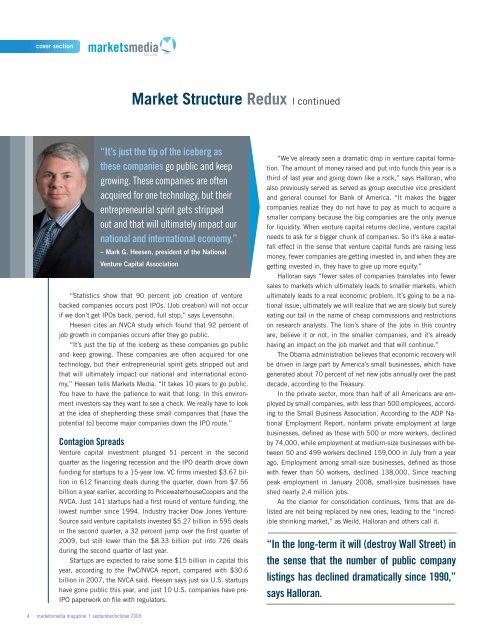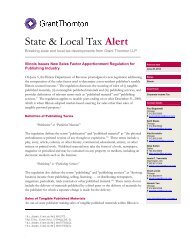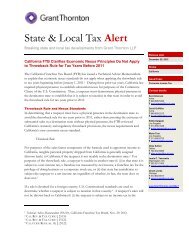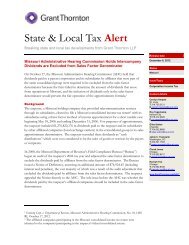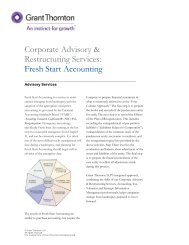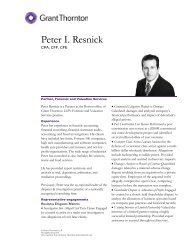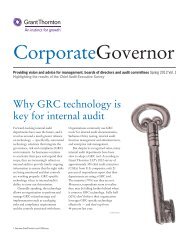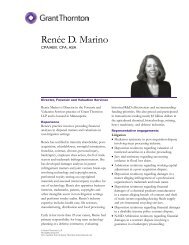Market Structure Redux - Grant Thornton LLP
Market Structure Redux - Grant Thornton LLP
Market Structure Redux - Grant Thornton LLP
Create successful ePaper yourself
Turn your PDF publications into a flip-book with our unique Google optimized e-Paper software.
cover section<br />
<strong>Market</strong> <strong>Structure</strong> <strong>Redux</strong> I continued<br />
“It’s just the tip of the iceberg as<br />
these companies go public and keep<br />
growing. These companies are often<br />
acquired for one technology, but their<br />
entrepreneurial spirit gets stripped<br />
out and that will ultimately impact our<br />
national and international economy.”<br />
– Mark G. Heesen, president of the National<br />
Venture Capital Association<br />
“Statistics show that 90 percent job creation of venture<br />
backed companies occurs post IPOs. (Job creation) will not occur<br />
if we don’t get IPOs back, period, full stop,” says Levensohn.<br />
Heesen cites an NVCA study which found that 92 percent of<br />
job growth in companies occurs after they go public.<br />
“It’s just the tip of the iceberg as these companies go public<br />
and keep growing. These companies are often acquired for one<br />
technology, but their entrepreneurial spirit gets stripped out and<br />
that will ultimately impact our national and international economy,”<br />
Heesen tells <strong>Market</strong>s Media. “It takes 10 years to go public.<br />
You have to have the patience to wait that long. In this environment<br />
investors say they want to see a check. We really have to look<br />
at the idea of shepherding these small companies that [have the<br />
potential to] become major companies down the IPO route.”<br />
Contagion Spreads<br />
Venture capital investment plunged 51 percent in the second<br />
quarter as the lingering recession and the IPO dearth drove down<br />
funding for startups to a 15-year low. VC firms invested $3.67 billion<br />
in 612 financing deals during the quarter, down from $7.56<br />
billion a year earlier, according to PricewaterhouseCoopers and the<br />
NVCA. Just 141 startups had a first round of venture funding, the<br />
lowest number since 1994. Industry tracker Dow Jones Venture-<br />
Source said venture capitalists invested $5.27 billion in 595 deals<br />
in the second quarter, a 32 percent jump over the first quarter of<br />
2009, but still lower than the $8.33 billion put into 726 deals<br />
during the second quarter of last year.<br />
Startups are expected to raise some $15 billion in capital this<br />
year, according to the PwC/NVCA report, compared with $30.6<br />
billion in 2007, the NVCA said. Heesen says just six U.S. startups<br />
have gone public this year, and just 10 U.S. companies have pre-<br />
IPO paperwork on file with regulators.<br />
“We’ve already seen a dramatic drop in venture capital formation.<br />
The amount of money raised and put into funds this year is a<br />
third of last year and going down like a rock,” says Halloran, who<br />
also previously served as served as group executive vice president<br />
and general counsel for Bank of America. “It makes the bigger<br />
companies realize they do not have to pay as much to acquire a<br />
smaller company because the big companies are the only avenue<br />
for liquidity. When venture capital returns decline, venture capital<br />
needs to ask for a bigger chunk of companies. So it’s like a waterfall<br />
effect in the sense that venture capital funds are raising less<br />
money, fewer companies are getting invested in, and when they are<br />
getting invested in, they have to give up more equity.”<br />
Halloran says “fewer sales of companies translates into fewer<br />
sales to markets which ultimately leads to smaller markets, which<br />
ultimately leads to a real economic problem. It’s going to be a national<br />
issue; ultimately we will realize that we are slowly but surely<br />
eating our tail in the name of cheap commissions and restrictions<br />
on research analysts. The lion’s share of the jobs in this country<br />
are, believe it or not, in the smaller companies, and it’s already<br />
having an impact on the job market and that will continue.”<br />
The Obama administration believes that economic recovery will<br />
be driven in large part by America’s small businesses, which have<br />
generated about 70 percent of net new jobs annually over the past<br />
decade, according to the Treasury.<br />
In the private sector, more than half of all Americans are employed<br />
by small companies, with less than 500 employees, according<br />
to the Small Business Association. According to the ADP National<br />
Employment Report, nonfarm private employment at large<br />
businesses, defined as those with 500 or more workers, declined<br />
by 74,000, while employment at medium-size businesses with between<br />
50 and 499 workers declined 159,000 in July from a year<br />
ago. Employment among small-size businesses, defined as those<br />
with fewer than 50 workers, declined 138,000. Since reaching<br />
peak employment in January 2008, small-size businesses have<br />
shed nearly 2.4 million jobs.<br />
As the clamor for consolidation continues, firms that are delisted<br />
are not being replaced by new ones, leading to the “incredible<br />
shrinking market,” as Weild, Halloran and others call it.<br />
“In the long-term it will (destroy Wall Street) in<br />
the sense that the number of public company<br />
listings has declined dramatically since 1990,”<br />
says Halloran.<br />
4<br />
marketsmedia magazine I september/october 2009


